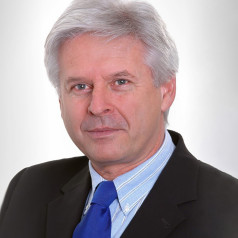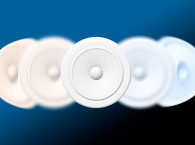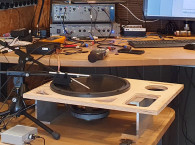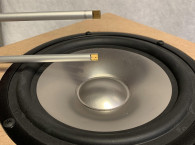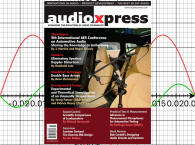
Even a perfectly linear loudspeaker produces two types of distortions due to the movement of its membrane. The movement creates Doppler distortions, a.k.a. phase modulation, as well as distortion stemming from the nonlinear amplitude modulation.
Doppler distortions generate non-harmonic spectral lines, which are independent from the listening distance and need to be eliminated for a good listening experience. Nonlinear amplitude modulation also generates non-harmonic spectral lines, but decreases with listening distance and it is a problem only at short listening distances. This article characterizes Doppler distortions and shows how to eliminate them.
A perfect sound reproduction requires a system able to translate the sound pressure of a source into an electrical audio signal and to translate that signal back into sound pressure without modification. To do that, system theory tells us that we first need a linear system and second a time invariant system.
The first requirement of linearity can be fulfilled by using acceleration feedback (AFB) [1]. With this technique the linearity of a loudspeaker can be improved such that harmonic and intermodulation distortions are reduced to below -60dB (0.1%) relative to the fundamental frequency. Figure 1 shows the sound pressure level (SPL) frequency response of an acceleration-controlled loudspeaker driver together with the harmonic distortions k2 and k3.
Obviously, with acceleration control technology, a sufficient linear system can be achieved with moderate effort. Above 100Hz, the harmonic distortions are below -60dB (0.1%). However, at low frequencies, harmonic k2 especially, is rising toward lower frequencies. The reason lies inter alia in the violation of the second requirement for time invariance. During sound recording, the membrane of a condenser microphone moves with an amplitude of about 1μm at low frequencies (20Hz) and high SPLs (100dB).
The same is valid for the tympanic membrane of the human ear. However, during playback a loudspeaker membrane may move up to 1cm amplitude to reproduce the recorded sound at 20Hz frequency and 100dB SPL. To put it in simple terms: We record at an almost fixed location in space, but we reproduce at a variable location in space. This 1 to 10,000 ratio of the membrane amplitudes between recording and reproduction leads to audible distortion, even for a perfectly linear loudspeaker.

Moving Membrane Phase Modulation
In the following example, the distance change (excursion or travel) of the membrane is assumed to be ±7mm from the rest position. The travel amplitudes of the membrane and the attached air molecules during playback generate an undesired phase modulation [2] also known as Doppler distortion, or Doppler effect, of the SPL at the receiver (microphone or ear).
Remember that SPL is strictly proportional to membrane acceleration in the frequency range of interest. Figure 2 illustrates how membrane excursion is translated into phase modulation. Comparing the waveform at the receiver with that of the transmitter shows the delay caused by the travel time over the distance of for example, D = 1m (Figure 3a). The small delay variations caused by the membrane movement s(t) become only visible when the receiver waveform is compared to the ideal receiver waveform without s(t), (Figure 3b, green waveform).
For further discussion the constant delay caused by the distance D is of no interest. The delay variations by the movement of the transmitter membrane, however, generate a phase modulation, which in turn generates additional spectral lines as we will see later. The delay s(t)/c shown in Figure 1, multiplied with 2*π*f, corresponds to the frequency depending phase contribution p(t) of the receiver waveform ar(t). The equation for the receiver waveform can therefore be rewritten as:
ar(t) = -S*(2*π*f)2*cos(2*π*f*t + p(t))
with the phase term:
p(t): = s(t)*f/c*2*π (1)
Without knowledge of the modulating frequency, a phase modulation cannot be differentiated from a frequency modulation. Therefore, the Doppler effect is sometimes said to be a frequency modulation. However, the equations above clearly show that the moving loudspeaker membrane generates an undesired phase modulation.


Imagine a high note being played back by a perfectly linear loudspeaker. Simultaneously, a low note with considerable membrane amplitude is being played back. The location at which the high note is generated travels with the membrane sound travel times to arrive at the receiver varies. So, different membrane positions s(t) translate into different arrival times at the receiver and depending on the frequency f, into different phases p(t) at the receiver according to equation (1) for p(t).
This principle is a general one and valid for any frequency, even when only a single frequency is reproduced. According to Equation 1, the phase of the sound pressure is proportional to membrane travel s(t) and frequency f. The speed of the sound c is 343m/s under normal conditions. At constant sound pressure level, the membrane excursion amplitude is the quadratic inverse of the frequency following the Inverse-Square Law [3]. s(t) in the nominator of Equation 1 increases quadratically toward lower frequencies. However, the nominator also contains frequency f, which is falling linearly toward lower frequencies. That partially compensates for the quadratic rise of the membrane amplitude toward lower frequencies.
Therefore, the phase deviation grows linearly toward lower frequencies at a given constant SPL (i.e., with a slope rising at 20dB per frequency decade toward lower frequencies). That behavior can be seen in Figure 1 for the second harmonic.

Time and Frequency Domain Phase Modulation
The effect of modulating the phase of a signal is well known. For the listener, it has the consequence that additional and especially non-harmonic spectral lines are generated and added to the original sound or spectrum (Figure 3). In the time domain, f is the frequency, S the amplitude, and st(t) the membrane and attached air molecule excursion at the transmitter. The following example uses f=30Hz at S=7mm membrane travel amplitude. al(t) is the acceleration of the loudspeaker membrane and the attached air molecules, the acceleration being strictly proportional to the sound pressure. The following equations use the mks (meter, kilogram, second) system.
f = 30
S = 7e-3
sl(t) = S*cos(2*π*f*t)
al = -S*(2*π*f)2*cos(2*π*f*t)
Due to the membrane movement the distance to the locally constant receiver varies with time resulting in phase pr(t).
c = 343
pr(t) = s(t)*f/c*2*π
Therefore, the waveform at the receiver becomes:
ar(t) = -S*(2*π*f)2*cos(2*π*f*t+pr(t))
It is obvious from Figure 3b that the waveform generated by the phase modulation contains additional frequencies, also with twice the frequency of the original waveform shifted 90 degrees in phase. The Fourier transformation of the waveform at the receiver in Figure 4 shows that further harmonic frequencies are generated, however, with significantly lower amplitudes.
Figure 4 shows a dominant second harmonic of the fundamental frequency at about -54dB. Now, one could think: Not nice, but not significantly disturbing. However, as soon as more than one frequency is reproduced — and we are rarely listening to single sine tones — the phase modulation creates the well-known Bessel spectral lines. The frequency components of the Bessel lines are non-harmonic and severely disturb a good listening experience.
For the calculation in the time domain, a second excursion signal with a frequency of 900Hz is added to the first one at 30Hz. Its amplitude A2 is determined to deliver the same acceleration (i.e., sound pressure) as the first frequency:
s(t) = A1*cos(2*π*f1*t+p1(t)) +
A2*cos(2*π*f2*t+p2(t))
The frequency domain display in Figure 5 shows the Bessel lines centered at the second frequency of 900Hz with the same SPL as the 30Hz frequency component.

membrane travel amplitude and the second one with 900Hz and the same SPL as the first one. Further weaker Bessel spectra appear at twice the second frequency and so on.
The largest two Bessel Lines at 900Hz ±30Hz are at -24,7dB (5.8%). Further spectral lines appear at 900Hz ±n times 30Hz (n being an integer number). The Bessel Functions of the first kind [4] describe the amplitudes of the generated spectral lines.
The spectrum would be generated by a two-way loudspeaker system with perfectly linear drivers and a crossover frequency of 1000Hz when reproducing the two tones. The Bessel lines lay non-harmonic and show considerable amplitudes. The only way to get rid of these disturbing additional frequencies is to use an acoustically stationary membrane as explained later.
As an approximation to that requirement, a very large membrane area can be used, which reduces the membrane excursion accordingly. That, however, conflicts with a sufficiently large dispersion angle at higher frequencies. The usual approximation to this problem in high-end loudspeakers: use several large area bass drivers with very low crossover frequency. In that case the membrane amplitude and consequently the phase modulation is reduced and the frequency band creating harmonic distortions, and the Bessel spectra is also reduced.
As said — an approximation of the ideal situation, but not a solution to the problem.

The second harmonic in the Figure 4 example is -54dB below the fundamental frequency of 30Hz. Other than the Nonlinear Amplitude Modulation (to be described in another article), the Phase Modulation is independent from the distance to the measurement microphone/listener. In the Figure 4 situation, measurement dynamics would be limited at 30Hz to -54dB for the second harmonic. The dependency of the second harmonic from the membrane amplitude is visualized in Figure 6.
Consequences for the Listening Experience
Figure 7 shows the amplitudes of the dominating Bessel lines as a function of the second frequency (the first frequency stays at 30Hz).

Characteristics of the Doppler spectral lines can be summarized as follows. First, as a result from Equation 1, the relative Doppler line amplitudes and the phase variation are proportional to frequency. Second, the Doppler line amplitudes are proportional to the total membrane excursion amplitude, which is usually mainly determined by the low-frequency components. Last, the Doppler amplitudes are independent from the measurement microphone/hearing distance.
The Phase Modulation shows the well-known Bessel spectrum in acoustic measurements. In Figure 8 the low-frequency spectral line is at 30Hz and the high-frequency spectral line is at 900Hz surrounded by the non-harmonic Bessel spectral lines. To isolate the Bessel spectrum from, for example the Non-Linear Amplitude Modulation, a larger microphone distance to the chassis needs to be chosen. Otherwise the spectral lines of the Non-Linear Amplitude Modulation, which have the same frequency components but are 90 degrees shifted in phase, blur the measurement. This can be achieved using the AudioChiemgau ModeCompensator.

Elimination of Phase Modulation/Doppler Effect
As the generation of phase modulation/Doppler effect is a deterministic physical effect, it can be compensated independently of the listening distance. Phase deviation compensation can be achieved if the actual position of the loudspeaker membrane is known at any point in time. The compensation is realized with a phase modulator [5] adding an equal, but opposite sign phase using the membrane position as control signal. In this way it is possible to create an acoustically stationary membrane (i.e., the acoustical center stands still), even when the membrane moves. This can be achieved with very little effort using acceleration-controlled loudspeakers, as they show a constant SPL amplitude and phase frequency response, which allows the continuous determination of the membrane position with high accuracy.
Example: When the membrane moves toward the listener, shortening the acoustic path length, the audio signal is electronically retarded by the phase modulator/delay generator such that the resulting sound “flight time” remains constant. So, from an acoustical point of view the membrane doesn’t move. Without movement of the acoustical center there is no Doppler effect/no Phase Modulation.
Figure 9 shows the same spectrum as in Figure 8 with active Doppler compensation. The undesired phase modulation is reduced to a level of -65dB with respect to the fundamental frequency, which corresponds to a reduction of more than 25dB. Other intermodulation products and the spectral lines of the Non-Linear Amplitude Modulation now dominate the spectrum around the 900Hz line.

Doppler spectral lines, which are non-harmonic to the fundamental frequencies and are therefore very disturbing for a good listening experience, can practically be eliminated using the technique of an acoustically stationary loudspeaker membrane. A linear analog phase modulator or a digital variable delay, both controlled by the actual membrane position, can be used for this purpose.
In a first step, the actual membrane position is calculated by integrating the measured membrane acceleration signal. In a second step, the derived time continuous membrane position signal is used to either control a voltage-controlled analog all-pass filter, or a voltage-controlled digital delay block, depending on whether an fully analog or a fully digital processing scheme is selected. As the movement of the membrane and the resulting distance changes correspond to a variable time delay of the sound pressure wave at the receiver, a digital variable delay block is more appropriate for compensation. For the digital implementation it is, however, necessary that all calculations and delay adjustments are calculated within a single sample period to avoid additional time delays.
In case of an analog realization, the all-pass filter is dimensioned such that it shows the same phase frequency response as the required time delay to be compensated. This is feasible up to a certain frequency, where the difference between the phase frequency responses between the all-pass filter and the time delay becomes significant. This happens outside the frequency band for the woofer or mid-range driver. As the membrane movement of a tweeter is very small, a Doppler compensation is not required. The generated Bessel spectral lines without Doppler compensation are significantly below -60dB.
Both alternative realizations of the Doppler compensation are implemented in the AudioChiemgau analog and digital audio
processors [1]. aX
References
[1] AudioChiemgau, audiochiemgau.de
[2] J. M. Pauly, “Lecture 9: Angle Modulation Part 2,” October 18, 2021, https://web.stanford.edu/class/ee179/lectures/notes09.pdf
[3] “Damping of sound level (decibel dB) vs. distance,” sengpielaudio, www.sengpielaudio.com/calculator-distance.htm
[4] “Bessel function,” Wikipedia, https://en.wikipedia.org/wiki/Bessel_function
[5] “Phase Modulation,” Wikepedia, https://de.wikipedia.org/wiki/Phasenmodulation
This article was originally published in audioXpress, October 2024.


